
7 April 2025
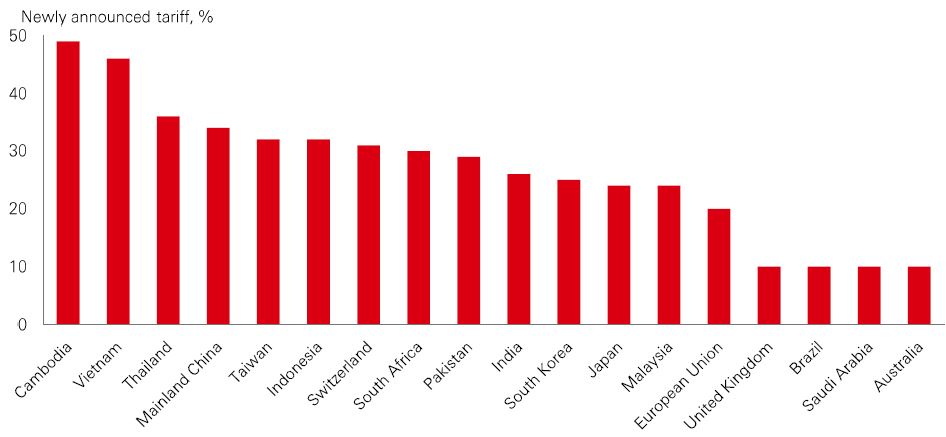
Investors had been steeling themselves for “liberation day”. But after last week’s tariff announcement, what happens next in investment markets?
Overall, the tariffs, any policy retaliation, and the economic consequences could significantly impact market dynamics. Policy uncertainty is now structurally elevated, partly because investors can’t be sure where tariffs will finally settle. And while recent hard data on GDP and profits have held up, a difficult mix of policy uncertainty, stagflation-lite news, and lower profits expectations, means that investor confidence could falter. In turn, sticky inflation postpones a pre-emptive easing by the Fed, which could have acted as a stock market shock absorber.
There are questions now about whether rest-of-the-world stocks can still outperform. After all, history suggests that when the US economy sneezes, the rest of the world catches a cold. But new domestic policy initiatives, especially in Europe and China, could support stock market performance. Likewise, US dollar weakness could act as a stimulus for the rest-of-the-world stocks. Plus, there could be relative winners from last week’s announcement.
The base case of ‘spinning around’ has envisaged policy uncertainty driving volatility this year. But if tariffs are fully implemented, a second scenario where growth and profits ‘topple over’ could come more vividly into play. High policy uncertainty continues to point to an agile approach to managing portfolios, meaning diversification and a selective approach that build resilience across geographies, asset classes and factors.
Private credit dealmaking enjoyed a pick-up in momentum in the final quarter of last year, outpacing levels seen in Q3, according to the latest data. Much of the activity was driven by refinancings and add-on financings to support company growth. M&A activity also rose modestly in late 2024, aided by improving equity valuations and record levels of private equity ‘dry powder’ (funds waiting to be deployed), although sponsor-backed M&A was below historical peaks.
Spreads remained under pressure but appeared to stabilise during Q4, following a modest tightening earlier in the year. Higher base rates kept all-in yields (in USD) in the low double digits for many direct lending deals. Meanwhile, default rates edged up slightly from Q3 but remain below historical averages.
Looking ahead, some private credit investment specialists note that demand remains strong as investors seek higher yields and stable income, even in a ‘higher for longer’ rate environment. And spreads continue to offer a premium over public markets. Overall, they believe that experienced managers with flexible strategies, prudent underwriting and active portfolio monitoring should continue to capture attractive risk-adjusted returns.
The value of investments and any income from them can go down as well as up and investors may not get back the amount originally invested. Past performance does not predict future returns. The level of yield is not guaranteed and may rise or fall in the future. For informational purposes only and should not be construed as a recommendation to invest in the specific country, product, strategy, sector, or security Any views expressed were held at the time of preparation and are subject to change without notice. Any forecast, projection or target where provided is indicative only and is not guaranteed in any way. HSBC Asset Management. Macrobond, Bloomberg, The White House. Data as at 7.30am UK time 04 April 2025.
In a number of EM bond markets, valuations are attractive with real yields considerably above historical medians, and with positive term premia. Gradual disinflation should mean many EM central banks can continue to ease policy, with some like India, Colombia, and the Czech Republic easing at a faster pace. Plus, while trade tariffs are often viewed as potentially inflationary in EM, they may actually be disinflationary in some countries by causing a supply glut in goods production. |
EM currencies, on the other hand, remain a tricky call. In 2024, hedging EM local-currency exposure boosted total returns as the US dollar made gains. Despite this year’s recovery in EM FX, currencies could remain volatile as policy uncertainty persists, with the US dollar playbook looking increasingly unpredictable.

Further out, analysts are expecting year-on-year profit growth of around 11% this year, down from expectations of 14% at the start of 2025 but still above long-run averages. Cooling optimism about the consumer has resulted in the expected share of profit growth from the consumer discretionary and staples sectors halving from their contribution levels last year. But the profit contribution from technology is still going strong – and expected to rise again in 2025. These high expectations could leave both tech stocks and the wider market vulnerable to disappointment. With earnings season arriving amid extreme world policy uncertainty, investors should prepare for surprises.
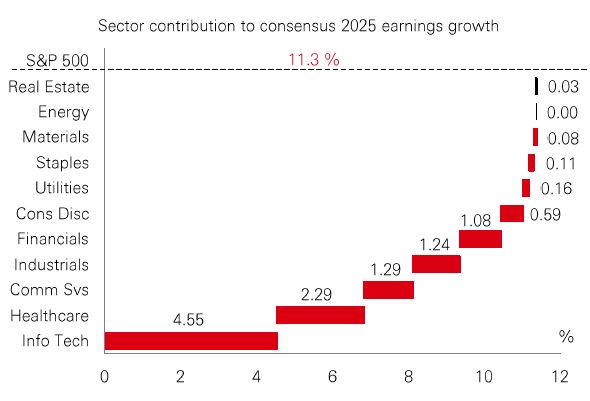
For those celebrating Easter this year, the ritual of hard-boiling and decorating eggs and gifting chocolate Easter eggs will be a significantly more expensive affair than in 2024. Both egg and cocoa prices have surged over recent months, as H5 strains of avian influenza have decimated the egg-laying hen population, and cocoa production in Ghana and the Ivory Coast – accounting for around 60% of global supply – has been hit by poor weather conditions. In Ghana, an outbreak of Swollen shoot disease, and mining and smuggling have also weighed on output. |
Climate change probably explains some of these disruptions. Industry experts have blamed record warm ocean temperatures for contributing to excessive rainfall in West Africa. And some studies have claimed the spread of Avian flu has been exacerbated by new patterns of seasonal bird migrations. Higher egg and chocolate prices are clearly not a big deal for the consumer outlook – eggs account for just 0.2% of the US CPI basket. But they are a stark reminder that we are living in a more volatile inflation regime versus the 2010s, with extreme weather, rising trade protectionism, supply chain rerouting, and active fiscal policy all playing their part in this story.
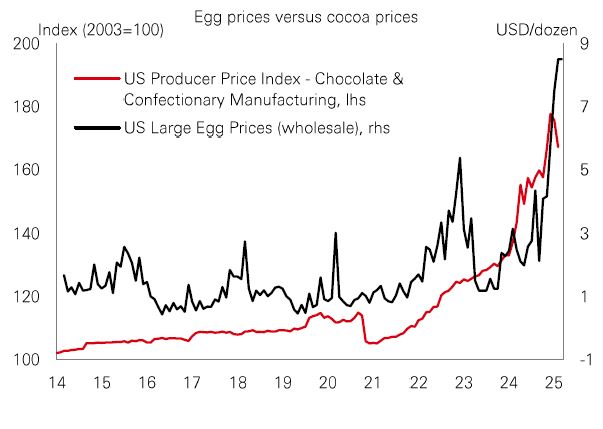
Past performance does not predict future returns. The level of yield is not guaranteed and may rise or fall in the future. For informational purposes only and should not be construed as a recommendation to invest in the specific country, product, strategy, sector, or security Any views expressed were held at the time of preparation and are subject to change without notice. Index returns assume reinvestment of all distributions and do not reflect fees or expenses. You cannot invest directly in an index. Any forecast, projection or target where provided is indicative only and is not guaranteed in any way. Source: HSBC Asset Management. Macrobond, Bloomberg, Datastream. Data as at 7.30am UK time 04 April 2025.
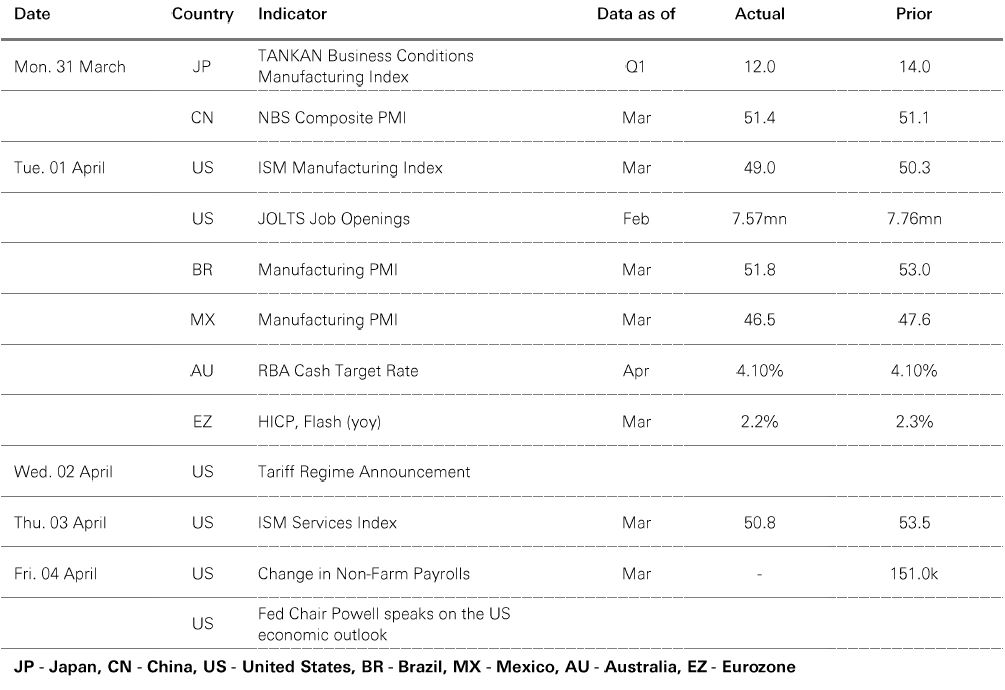
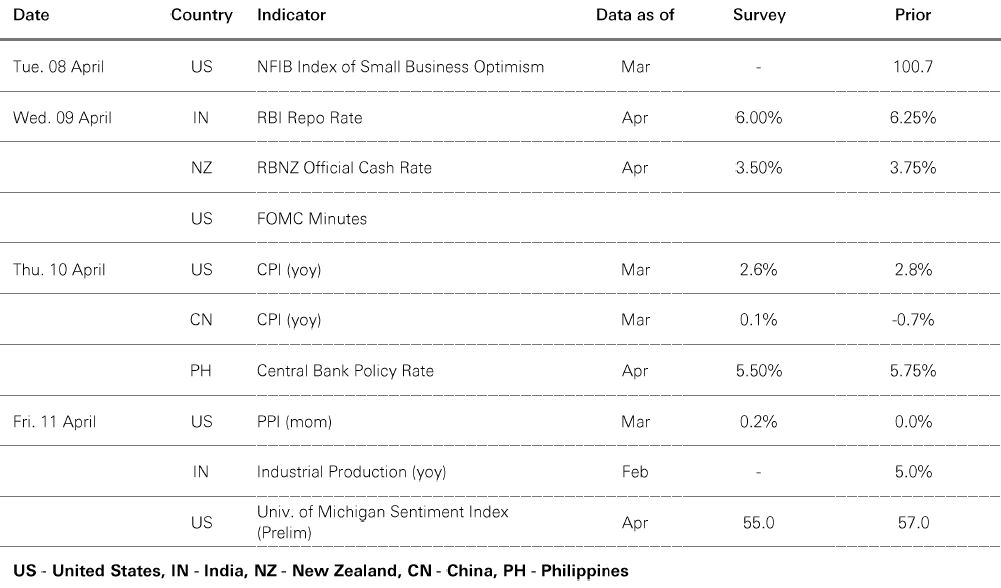
Source: HSBC Asset Management. Data as at 7.30am UK time 04 April 2025. For informational purposes only and should not be construed as a recommendation to invest in the specific country, product, strategy, sector or security. Any views expressed were held at the time of preparation and are subject to change without notice.
Heightened global trade uncertainty weighed on risk markets, with the US DXY dollar index on the defensive. Oil prices declined on rising global demand concerns, and gold consolidated after recent gains. Core government bonds rallied, led by US Treasuries. The front-end of the US yield curve is factoring in 3-4 Fed rate cuts over the next 12 months. New data showed more weakness in US consumer confidence. US credit spreads widened, with IG outperforming HY. US equities saw broad-based falls amid weakening 2025 earnings expectations. The Euro Stoxx 50 index declined on rising eurozone growth concerns. Japan’s Nikkei 225 dropped markedly, with lower JGB yields weighing on financials. EM Asia stock markets posted losses, led by South Korea’s tech-dominant Kospi index. The Hang Seng, Shanghai Composite and India’s Sensex indices all declined. Latin American equities were resilient.






We’re not trying to sell you any products or services, we’re just sharing information. This information isn’t tailored for you. It’s important you consider a range of factors when making investment decisions, and if you need help, speak to a financial adviser.
As with all investments, historical data shouldn’t be taken as an indication of future performance. We can’t be held responsible for any financial decisions you make because of this information. Investing comes with risks, and there’s a chance you might not get back as much as you put in.
This document provides you with information about markets or economic events. We use publicly available information, which we believe is reliable but we haven’t verified the information so we can’t guarantee its accuracy.
This document belongs to HSBC. You shouldn’t copy, store or share any information in it unless you have written permission from us.
We’ll never share this document in a country where it’s illegal.
This document is prepared by, or on behalf of, HSBC UK Bank Plc, which is owned by HSBC Holdings plc. HSBC’s corporate address is 1 Centenary Square, Birmingham BI IHQ United Kingdom. HSBC UK is governed by the laws of England and Wales. We’re authorised by the Prudential Regulation Authority (PRA) and regulated by the Financial Conduct Authority (FCA) and the PRA. Our firm reference number is 765112 and our company registration number is 9928412.